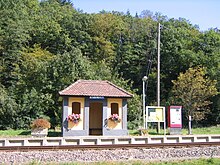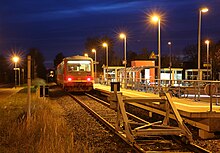A passing loop or passing siding is a place on a single line railway or tramway, often located at or near a station, where trains or trams travelling in opposite directions can pass each other. Trains/trams going in the same direction can also overtake, provided that the signalling arrangement allows it. A passing loop is double-ended and connected to the main track at both ends, though a dead end siding known as a refuge siding, which is much less convenient, can be used. A similar arrangement is used on the gauntlet track of cable railways and funiculars, and in passing places on single-track roads.

Nürnberg Hauptbahnhof or Nuremberg Central Station is the main railway station serving the city of Nuremberg in Germany. It is the largest station in north Bavaria and belongs to the 20 stations in the highest category of importance allocated by DB Station&Service.
The railways in Germany use several abbreviations to differentiate between various types of stations, stops, railway facilities and other places of rail service.
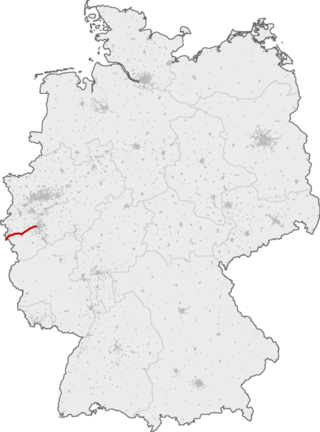
The Cologne–Aachen high-speed line is the German part of the Trans-European transport networks project high-speed line Paris–Brussels–Cologne. It is not a newly built railway line, but a project to upgrade the existing railway line which was opened in 1841 by the Rhenish Railway Company. When it was continued into Belgium in 1843, it became the world's first international railway line.

Dresden Hauptbahnhof is the largest passenger station in the Saxon capital of Dresden. In 1898, it replaced the Böhmischen Bahnhof of the former Saxon-Bohemian State Railway, and was designed with its formal layout as the central station of the city. The combination of a station building on an island between the tracks and a terminal station on two different levels is unique. The building is notable for its train-sheds, which are roofed with Teflon-coated glass fibre membranes. This translucent roof design, installed during the comprehensive restoration of the station at the beginning of the 21st century, allows more daylight to reach the concourses than was previously possible.

Augsburg Hauptbahnhof is the main railway station in the Bavarian city of Augsburg, situated in southern Germany. It is classified by Deutsche Bahn as a category 2 station and has 12 platform tracks.

Boppard Hauptbahnhof is a station in the town of Boppard in the German state of Rhineland-Palatinate. It is located on the outskirts of the town near the Rhine. It is at a railway junction on the West Rhine Railway between Köln Hauptbahnhof and Mainz Hauptbahnhof, and it is the starting point of the Hunsrück Railway (Hunsrückbahn) to Emmelshausen. It has three platform tracks.

Erfurt Hauptbahnhof or Erfurt Central Station is the central railway station at Erfurt in Germany. It is an important junction on the German rail network, served by numerous local and long-distance rail services. Immediately north of the station is Erfurt's city centre. The station was used by approximately 12.5 million passengers in 2006, an average of about 34,000 per day. The station lies on the Thüringer Bahn, which connects Halle to Bebra. It is served also by the Erfurter Bahn.

Hamburg Dammtor is a railway station for long distance, regional and suburban trains on the Hamburg-Altona link line, located in Central Hamburg, Germany. In front is a bus station of the same name for public transport.

The Mannheim–Saarbrücken railway is a railway in the German states of Baden-Württemberg, Rhineland-Palatinate and the Saarland that runs through Ludwigshafen am Rhein, Neustadt an der Weinstraße, Kaiserslautern, Homburg and St. Ingbert. It is the most important railway line that runs through the Palatinate. It serves both passenger and freight transport and carries international traffic.

The Ländches Railway (Ländchesbahn) is a single-track non-electrified branch railway line between Wiesbaden and Niedernhausen, in the German state of Hesse. The 19.6-kilometre (12.2 mi) long line was opened in 1879. It is now Deutsche Bahn route 627 and route 21 of the Rhein-Main-Verkehrsverbund.

Göhrde station is a railway halt on the Dannenberg–Lüneburg railway in the northeastern part of the German state of Lower Saxony. The former through station in Breese am Seißelberge in the municipality of Nahrendorf was the destination station for imperial hunts in the nearby state forest of Göhrde. It was built in 1874 by the Berlin-Hamburg Railway Company on the old Wittenberge-Buchholz line at kilometre stone 196.3 and is a protected monument.

A train station, railway station, railroad station or depot is a railway facility where trains stop to load or unload passengers, freight or both. It generally consists of at least one platform, one track and a station building providing such ancillary services as ticket sales, waiting rooms and baggage/freight service. If a station is on a single-track line, it often has a passing loop to facilitate traffic movements.

The Aachen–Mönchengladbach railway is a main line in the German state of North Rhine-Westphalia. It is an important link between the Ruhr and Belgium for freight trains and is served by regional passenger trains. The line was built by the Aachen-Düsseldorf-Ruhrort Railway Company and is one of the oldest lines in Germany, which was opened between 1852 and 1854.

Neustadt (Weinstr) Hauptbahnhof – called Neustadt a/d. Haardt until 1935 and from 1945 until 1950 – is the central station of in the city of Neustadt in the German state of Rhineland-Palatinate. In addition to the Hauptbahnhof, Rhine-Neckar S-Bahn services stop at Neustadt (Weinstr) Böbig halt (Haltepunkt). Mußbach station and Neustadt (Weinstr) halt, opened on 19 November 2013, are also located in Neustadt.

Wattenscheid station is on the Witten/Dortmund–Oberhausen/Duisburg railway. It is one of two stations in the formerly independent city of Wattenscheid, now a district of the city of Bochum in the German state of North Rhine-Westphalia. The other station is Wattenscheid-Höntrop. In late 2007, Wattenscheid station was downgraded to a Haltepunkt. It is located just south of central Wattenscheid, next to the A 40 autobahn on the western edge of an industrial area.
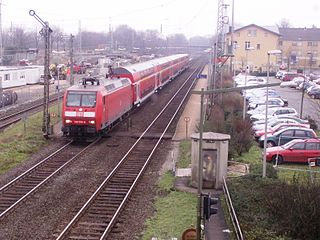
Lindern station is in Lindern in the German state of North Rhine-Westphalia on the Aachen–Mönchengladbach railway. It is classified by Deutsche Bahn as a category 4 station.
The Pockau-Lengefeld–Neuhausen railway, one of two lines also called the Flöha Valley Railway, is a branch line in the German state of Saxony. It runs in the valley of the Flöha from Pockau via Olbernhau to Neuhausen. Since 2001, the route has been operated by Erzgebirgsbahn, part of Deutsche Bahn's RegioNetz subsidiary.
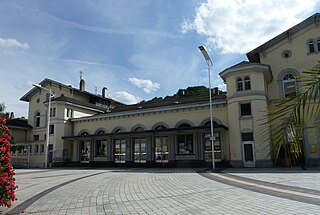
Bad Ems is a station in the town of Bad Ems in the German state of Rhineland-Palatinate. It is on the Lahntal railway (Koblenz–Wetzlar). The entrance building is heritage-listed.

The Mannheim–Weinheim railway is a metre-gauge railway between Mannheim-Neckarstadt-Ost/Wohlgelegen and Weinheim, mainly in the German state of Baden-Württemberg. It was built by the former Oberrheinischen Eisenbahn-Gesellschaft AG, later MVV OEG AG and is now operated by MVV Verkehr GmbH and RNV according to Eisenbahn-Bau- und Betriebsordnung für Schmalspurbahnen. However, the line is still owned by MVV Verkehr AG as the successor to the OEG. It is operated as a branch line using electronic direct traffic control.
